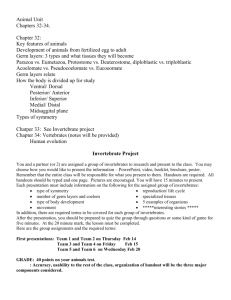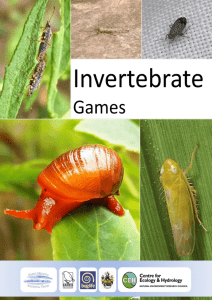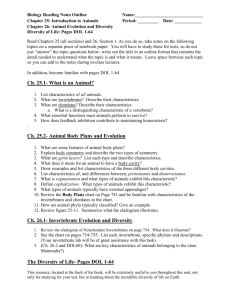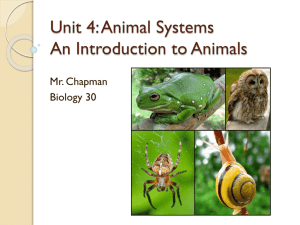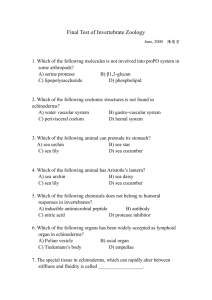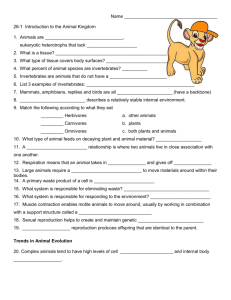on different species of submerged macrophytes* The abundance of phytophilous invertebrates
advertisement
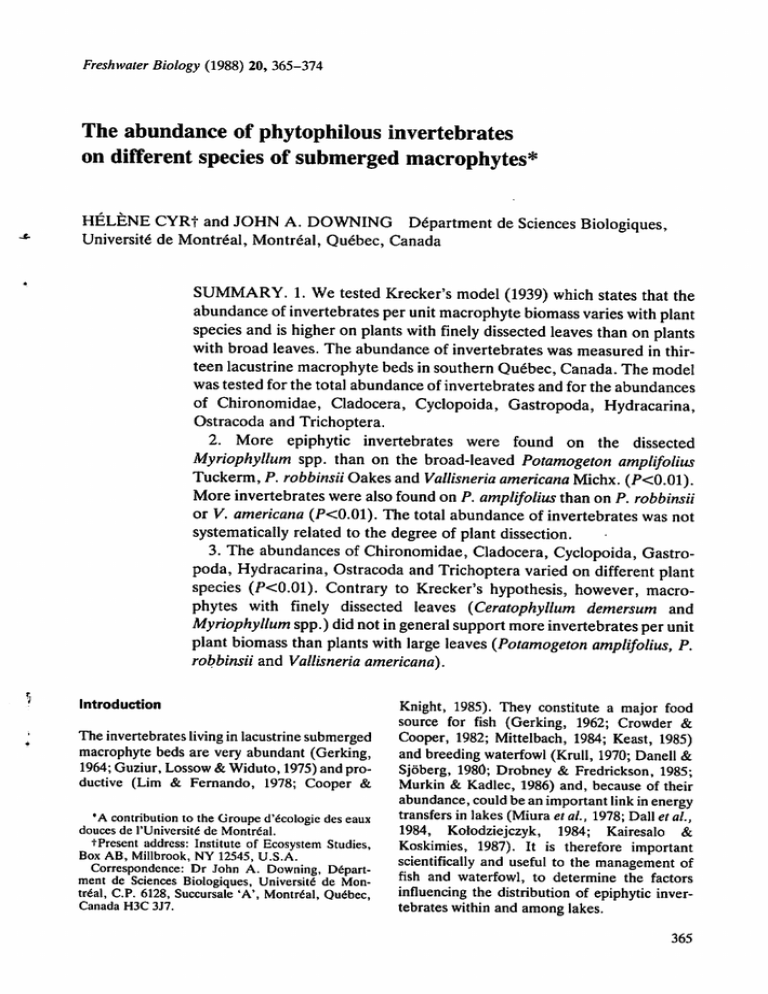
Freshwater Biology (1988) 20, 365-374
The abundance of phytophilous invertebrates
on different species of submerged macrophytes*
HELENE CYRf and JOHN A. DOWNING
Department de Sciences Biologiques,
University de Montreal, Montreal, Quebec, Canada
SUMMARY. 1. We tested Krecker's model (1939) which states that the
abundance of invertebrates per unit macrophyte biomass varies with plant
species and is higher on plants with finely dissected leaves than on plants
with broad leaves. The abundance of invertebrates was measured in thir
teen lacustrine macrophyte beds in southern Quebec, Canada. The model
was tested for the total abundance of invertebrates and for the abundances
of Chironomidae, Cladocera, Cyclopoida, Gastropoda, Hydracarina,
Ostracoda and Trichoptera.
2. More epiphytic invertebrates were found on the dissected
Myriophyllum spp. than on the broad-leaved Potamogeton amplifolius
Tuckerm, P. robbinsii Oakes and Vallisneria americana Michx. (P<0.01).
More invertebrates were also found on P. amplifolius than on P. robbinsii
or V. americana (P<0.01). The total abundance of invertebrates was not
systematically related to the degree of plant dissection.
3. The abundances of Chironomidae, Cladocera, Cyclopoida, Gastro
poda, Hydracarina, Ostracoda and Trichoptera varied on different plant
species (P<0.01). Contrary to Krecker's hypothesis, however, macro
phytes with finely dissected leaves {Ceratophyllum demersum and
Myriophyllum spp.) did not in general support more invertebrates per unit
plant biomass than plants with large leaves {Potamogeton amplifolius, P.
robbinsii and Vallisneria americana).
Introduction
The invertebrates living in lacustrine submerged
macrophyte beds are very abundant (Gerking,
1964; Guziur, Lossow & Widuto, 1975) and pro
ductive (Lim & Fernando, 1978; Cooper &
*A contribution to the Groupe d'dcologie des eaux
douces de l'Universit£ de Montreal.
tPresent address: Institute of Ecosystem Studies,
Box AB, Millbrook, NY 12545, U.S.A.
Correspondence: Dr John A. Downing, Depart
ment de Sciences Biologiques, University de Mon
treal, C.P. 6128, Succursale 'A', Montreal, Quebec,
Canada H3C 3J7.
Knight, 1985). They constitute a major food
source for fish (Gerking, 1962; Crowder &
Cooper, 1982; Mittelbach, 1984; Keast, 1985)
and breeding waterfowl (Krull, 1970; Danell &
Sjoberg, 1980; Drobney & Fredrickson, 1985;
Murkin & Kadlec, 1986) and, because of their
abundance, could be an important link in energy
transfers in lakes (Miura et al., 1978; Dall et al.,
1984, Kolodziejczyk,
1984; Kairesalo &
Koskimies, 1987). It is therefore important
scientifically and useful to the management of
fish and waterfowl, to determine the factors
influencing the distribution of epiphytic inver
tebrates within and among lakes.
365
366
H&ltne Cyr and John A. Downing
The abundance of phytophilous invertebrates
(Rosine, 1955), might act as sieves that filter and
is related to the biomass of macrophytes (Vin
accumulate phytoplankton and detrital particles
cent, Lafontaine & Caron, 1982; Downing,
from the water (Rooke, 1984,1986b) and might
1986) but most authors agree that epiphytic
offer more protection to the invertebrates from
their predators (Harrod, 1964; Dvorak & Best,
1982).
invertebrates are not equally abundant on all
plant species (Soszka, 1975; Gerrish & Bristow,
1979; Rooke, 1986a, b). Krecker (1939) sug
from qualitative observations, that
gested,
plants
with
dissected
leaves
support
sys
tematically more invertebrates than plants with
broad leaves. Plants with dissected leaves would
provide more substrate for the growth of peri-
phytic algae (Dvorak & Best, 1982) which is an
important food source for invertebrates (Down
ing, 1981; Cattaneo, 1983), would offer more
surface area for the support of invertebrates
Krecker's model has been confirmed by some
studies in lakes and streams (Andrews & Hasler,
1943; Rosine, 1955; Gerking, 1957; Gerrish &
Bristow, 1979; Dvorak & Best, 1982; Rooke,
1986a, b) but some contradictory observations
exist (Bownik, 1970; Krull, 1970; Kofinkova,
1971). The model could provide an important
tool in fisheries and wildlife management but its
predictions have never been tested quan
titatively in different macrophyte beds. This
FIG. 1. The plant species among which the abundance of epiphytic invertebrates is compared, (a) Ceratophyllum
demersum L., x3/i; (b) Myriophyllum sp., xVt; (c) Utricularia sp., x¥*\ (d) Potamogeton amplifolius Tuckerm, x%;
(e) P. robbinsii Oakes, x% (f) Vallbneria americana Michx, xVs. Redrawn from Fassett (1957).
Phytomacrofaunal abundance versus plant type
367
research presents a test of the hypothesis that the
cients are proportional to the abundance of
abundance of invertebrates is higher on plants
invertebrates collected per unit macrophyte
biomass. The regression coefficients associated
with finely dissected leaves than on plants with
broad leaves.
with six plant species (Fig. 1) were compared to
test Krecker's model.
Methods
The abundance of epiphytic invertebrates is rel
Thirteen sites were sampled in ten lakes
within a 150 km radius of Montreal, Quebec
(45°31'N, 73°36'W). We chose very different
macrophyte beds (Table 1) in an effort to seek
ated to plant biomass, macrophyte bed charac
general patterns of invertebrate distribution.
teristics and sampling date (Cyr & Downing,
The macrophyte beds were monospecific or
1988). We therefore used a regression technique
(Downing, 1986), to estimate the regression
mixed and average macrophyte standing stocks
ranged from very low (9 g trr2) to greater than
the world average (397 g m~2; Duarte, Kalff &
Peters, 1986). Macrophyte beds were located in
coefficients associated with the biomass of
different plant species. These regression coeffi
TABLE 1. Characteristics of the thirteen sites and date of sampling (SD; 3 July is day 1,26 August is day 55). The
average measures of plant standing stock (PBA), proportion by weight of sediment water (SWC) and organic
matter content (SOC), total phosphorus concentration in the water around the macrophyte bed (TP), and rooting
depth of the macrophyte bed (Z) are presented for each site with their standard deviations in parentheses.
Macrophyte species composition includes all plant species, in decreasing order of importance, that represent more
than 1%, by dry weight, of the total macrophyte biomass. The plants are: C, Chara sp.; CC, Cabomba caroliniana;
CD, Ceratophyllum demersum; EC, Elodea canadensis; I, Isoetes sp.; J, Juncus sp.; M, Myriophyllum spicatum
and M. humile in Lake Des lies; NF, Najas flexilis; NH, Nitella hyalina; P, Potamogeton sp.; PA, P. amplifolius;
PE, a mixture of P. epihydrus and P. gramineus; PR, P. robbinsii; S, Sagittaria sp.; U, Utricularia sp.; VA,
Vallisneria americana.
PBA
Lake
SD
(g m"2)
Brome
34
9
SWC
_
SOC
_
(17)
Champlain
(Baie Venise)
42
Champlain
(Kings Bay)
54
Des lies
55
Echo
Fournelle
Ludger
Magog
88
12
7
27
40
276
(177)
Memphremagog
0.014
1.8
(0.2)
VA, M, P
3.1
(0.1)
VA, PR, M,
PA, EC
2.2
(0.2)
M, PR, I, S
12
(0.005)
(2)
(2)
65
0.36
(0.02)
0.021
(0.003)
63
(120)
0.48
(0.03)
0.013
(0.003)
256
(116)
0.96
(0.01)
0.014
8
(0.003)
(2)
40
(84)
0.48
(0.02)
0.033
(0.004)
131
0.28
(0.06)
0.020
(0.008)
38
(12)
7
11
0)
1.9
(4)
(0.2)
PA,J, U,
C, NH, PR
1.4
PR, EC, M,
(0.04)
0.60
(0.10)
(0.008)
48
(80)
0.32
(0.03)
(0.000)
(1)
76
0.19
(0.02)
0.007
(0.002)
12
0.46
(0.02)
0.027
(0.004)
10
Memphremagog
21
(Cove Is. Bay)
(30)
28
182
(108)
PA
12
0.026
(0.004)
28
0.035
12
0.022
1.4
(0.01)
PR, PA, EC
85
(86)
48
'
2.0
(0.2)
1
0.40
VA, EC
32
397
(428)
Memphremagog
(Three Sisters)
1.7
Macrophyte
species
composition
(0.2)
(8)
0.25
(0.06)
Z
(m)
(2)
14
(Sargent Bay)
Quenouilies
-
16
(88)
(108)
Massawippi
-
(88)
TP
Qig h1)
(7)
(0.04)
CD, P
2.7
(0.2)
M
2.0
P, M, VA
(2)
(0.6)
7
3.0
(0.4)
M, PR, VA,
PE, EC
1.4
(0.1)
P, VA, CC,
NH, EC, NF
1.6
(0.00)
PR
(4)
(2)
368
Helene Cyr and John A. Downing
oligo-mesotrophic to eutrophic lakes at depths
1985). Depth of the water column at each site
between 1.4 and 3.1 m. The plants were growing
was also measured (±0.1 m) at six points along
on sediments ranging from sand to silt and con
the transect. Average measures of plant stand
tained little organic matter.
ing stock (twenty-five samples), sediment char
Each macrophyte bed was sampled once in
acteristics
(twenty-five
samples),
total
July or August 1984. The phytophilous inver
phosphorus concentration (six samples) and
tebrates were collected in 6 litre plastic box
rooting depth
samplers gently closed over plants (Downing,
measures) were calculated for each site. Sam
of the macrophyte
bed
(six
1986). Fifteen to twenty samples were randomly
pling dates were transformed to numerical days
distributed at different depths in the bed, on
(3 July as Day 1 to 26 August as Day 55; Table 1)
either side of a 50 m transect. We collected 231
and included in the analysis.
samples. The amount and species composition
The abundance of invertebrates collected in
of macrophytes from which the invertebrates
each box sample was related to the biomass of
were collected varied among samples. In the
plants in the box, averages of macrophyte bed
laboratory, the plants were thoroughly washed
characteristics and sampling date, using forward
to detach the invertebrates, separated by species
stepwise multiple
(Fassett, 1957), dried at 60°C and weighed (±0.1
Logarithmic or fourth-root transformation was
mg). The invertebrates retained on a 100 //m
applied to measures of invertebrate abundance
linear regression
analysis.
filter were preserved in 80% ethanol (with 1%
and plant biomass to achieve normality and
glycerin to prevent desiccation), separated into
homoscedasticity of the residuals. For each
major taxonomic groups and counted at 16 x
invertebrate taxon we obtained an equation of
magnification.
the form:
We
collected
amphipods,
cladocerans, copepods, flatworms, gastropods,
insect larvae, isopbds, leeches, nematodes,
oligochaetes, ostracods, tardigrades and water
mites (Hydracarina). In many samples oligo
chaetes were found broken probably from the
contact of unanaesthetized animals with the
ethanol, and could not be counted. They are
omitted from the analysis presented here.
Macrophyte
bed
characteristics
were
measured and averaged at each site. Areal plant
standing stock was determined using twenty-five
112 cm2 quadrats (Downing & Anderson, 1985)
collected at the same time as box samples, but
distributed at different random locations along
the 50 m transect. The plants from each quadrat
were dried at 60°C and weighed (±0.1 mg). A
sample of the top 10 cm of sediment was col
lected from the centre of each emptied quadrat
using a hand-held 5.6 cm diameter corer. The
homogenized sediments were dried at 60°C to
constant weight to determine water content and
subsequently ashed at 550°C to constant weight
to determine organic matter content. Total
phosphorus concentration
in the water was
measured in six samples collected 15-30 cm
below lake surface, at 10 m intervals along the
transect. Total phosphorus was measured by the
ascorbic acid colorimetric method following a
Yi=blXl+b2X2+. . . bkXk+a
where Yt is the transformed abundance of inver
tebrates from taxon H\XX to Xk are transformed
macrophyte biomasses collected in the box sam
ples, environmental variables and sampling day,
b\ to bk are fitted coefficients, and 'a' is the
stochastic error term.
The regression coefficients associated with the
biomass of different macrophyte species are pro
portional to the number of invertebrates col
lected per unit plant biomass (Downing, 1986).
Therefore, a comparison of invertebrate abun
dance on different plant species was achieved
through Mest comparisons of regression coeffi
cients (Baillargeon & Rainville, 1979, p. 728).
This analysis was repeated for total inverte
brates, Chironomidae, Cladocera, Cyclopoida,
Gastropoda,
Hydracarina,
Ostracoda
and
Trichoptera. According to Krecker's model, the
regression coefficients associated with the finely
dissected
Ceratophyllum
phyllum spp. and
demersum,
Myrio-
Utricularia sp. should be
higher than the regression coefficients of the
broad-leaved Potamogeton amplifolius, P. robbinsii and Vallisneria americana.
Results
persulphate digestion (American Public Health
Multivariate analysis showed that the abun
Association, American Water Works Associa
dance of epiphytic invertebrates was signifi
tion & Water Pollution Control Federation,
cantly related to plant biomass, macrophyte bed
Phytomacrofaunal abundance versus plant type
characteristics and sampling date. Together,
these variables explained 51-70% of the
dissection. In the multivariate equation for total
invertebrate abundance (Table 2), the regres
sion coefficients associated with the biomass of
Myriophyllum spp., P. amplifolius, Utricularia
variability in transformed invertebrate abun
dance (Tables 2 and 4) and are discussed in detail
elsewhere (Cyr & Downing, 1988). In this article
sp., C. demersum, P. robbinsii and V. americana
were compared with Mests. Several differences
were found (Table 3). Myriophyllum spp. sup
ported more invertebrates than the broad leaved
P. amplifolius, P. robbinsii and V. americana
(P<0.01). The finely dissected C. demersum and
we concentrate on the regression coefficients
associated with
different species
369
of macro-
phytes, employing environmental characteris
tics and sampling date to correct statistically for
the effect of physical, chemical and temporal
differences among sites.
Utricularia sp., however, did not support higher
The total abundance of invertebrates col
invertebrate abundances than the broad leaved
lected per unit macrophyte biomass was not sys
P. amplifolius, P. robbinsii and V. americana
(P>0.2). Significant differences were also found
tematically
related to the
degree
of plant
TABLE 2. Tabular form of the multivariate equation relating the fourth
root of total invertebrate abundance (without oligochaetes) to the fourth
root of the biomass of plant species, macrophyte bed characteristics and
sampling date (adjusted R2=0.59, F=27, n=186). The regression coeffi
cients are all significantly different from zero (P(r)<0.05) and are pre
sented with their standard errors. The abbreviations for plant species and
macrophyte bed characteristics are as in Table 1. V is the stochastic
disturbance term. The units for the regression coefficients associated with
each plant species are (numbers)0-25/^)025.
Independent
variables
Regression
Standard
coefficients
errors
(M)0.25
3.2
2.5
2.4
2.0
(PA)025
(U)0.25
(CD)0-25
(PR)0-"
(VA)0-*5
PBA
0.3
0.3
0.9
0.5
0.3
0.3
0.001
1.9
1.4
0.006
-1.9
Z
soc
SD
0.2
11
0.005
52
0.038
4.5
a
TABLE 3. T-test comparisons between pairs of regression coefficients associated with the biomass of macrophyte
species for the total abundance of invertebrates (Table 2). No Bonferonni correction for multiple comparisons was
applied to the significance levels. (ns,P>0.01; **P<0.01;***P<0.001)
Ceratophyllum
Myriophyllum
Utricularia
spp.
sp.
Potamogeton
amplifolius
Potamogeton
robbinsii
americana
ns
ns
ns
ns
ns
* *
***
* * *
ns
ns
ns
**
* *
demersum
Myriophyllum
ns
Vallisneria
spp.
Utricularia
sp.
Potamogeton
amplifolius
Potamogeton
robbinsii
ns
370
Helbne Cyr and John A. Downing
among broad-leaved plants. More invertebrates
cant
were collected on P. amplifolius than P. robbin
differences in the number of invertebrates g"1
sii or V. americana (P<0.01).
macrophyte supported by various plant species
(Table 5). Comparisons of the five most com
We also sought relationships between the
abundance
of
Cyclopoida,
Chironomidae,
Gastropoda,
Cladocera,
mon
differences
macrophyte
(P<0.01),
species
suggesting
entering
the
Hydracarina,
multivariate equations (C. demersum, Myrio-
Ostracoda and Trichoptera and the degree of
phyllum spp., P. amplifolius, P. robbinsii, V.
plant dissection. A comparison of the regression
americana), however, showed no tendency for
coefficients in the equations for each inverte
plants with dissected leaves (Fig. la, b, c) to
brate taxon (Table 4) revealed several signifi
support more invertebrates than broad-leaved
TABLE 4. MuUivariate equations relating the number of phytophilous invertebrates collected in box samples to
the biomass of plant species, macrophyte bed characteristics and sampling date. All equations are highly significant
(P(F) <0.0001). The adjusted /?2, the F value and the sample size (n) are presented for each equation. The
invertebrate taxa are: CHIR, chironomids; CLAD, total cladocerans; CYCL, cyclopoids; GAST, gastropods;
ACAR, water mites; OSTR, ostracods; TRIC, trichopterans. All abbreviations for plant species and macrophyte
bed characteristics are as in Table 1.
Adj.
i?2
Equations
(CHIR)0-25=2.3(J)0-2S+1.8(PA)0-2S+1.7(PR)0-25-l-1.7(M)O25+1.2(CD)O25+O.7(VA)0-25
0.59
34
231
0.70
58
193
0.51
30
199
log(GAST)=8.2(J)+1.0(P)+1.0(PA)+0.5(PR)+0.3(VA)+0.3(M)
-0.006 PBA-0.9SWC-37SOC+0.04TP+1.0Z-0.02SD+0.6
0.63
29
199
(ACAR)"-25=2.0(PR)«-25+1.8(PA)025+1.0(CD)"25+0.6(VA)n25+0.5(M)02S-0.002PBA
0.51
34
229
(OSTR)°-25=2.5 (CD)0-^+2.1 (VA)° 2S+1.6 (PR)"-25 +1.6 (U)O:25+1.4 (EC)0■*+1.2 (M)"25
+0.8(PA)°-25+0.8(P)°-25-0.005PBA +0.1TP+1.1Z-0.6
0.70
47
224
log(TRIC)=16.0(NH)+l.l(CC)+0.8(CD)+0.7(PA)
+0.4(PR)+0.2(M)+0.0007PBA+0.02TP +0.01 SD-0.3
0.52
24
197
+0.005 PBA+0.04TP-1.1Z+0.01SD+2.9
log(CLAD)=0.49(M)+0.48(P)+0.39(PA)+0.15(PR)
+0.002 PBA+41 SOC-0.8Z+0.02SD+2.3
(CYCL)o-25=1.4(M)025+1.3(PA)°-25+0.6(PR)025
+0.004 PBA+50 SOC-0.5 Z+0.01 SD+2.0
+0.03 TP+1.3
TABLE 5. T-test comparisons between pairs of regression coefficients associated with the biomass of macrophyte
species for seven invertebrate taxa (Table 4). For each comparison, the plant species on the left had a significantly
(P<0.01) greater (+), no different (ns) or lesser (-) regression coefficient than the plant species on top. No
Bonferonni correction for multiple comparisons was applied to the significance levels. The invertebrate taxa are:
'C, Cyclopoida; 'D', Chironomidae (Diptera); *F\ Cladocera; 'G', Gastropoda; 'H\ Hydracarina; 'O\
Ostracoda; T\ Trichoptera.
Myriophyllum
Ceratophyllum
demersum
spp.
Potamogeton
amplifolius
Potamogeton
robbinsii
americana
1(O)
3 (D,H,T)
0
1(O)
3 (D,H,T)
0
0
0
3 (D.0.T)
3 (D,H,O)
0
(+)
0
(ns)
4(C,D,F,O)
(-)
(+)
3 (G,H,T)
2 (C,F)
3 (D,G,O)
2 (H,T)
1(D)
2 (G,H)
4 (C,F,G,T)
2 (D, H)
3 (D,G,H)
0
1(0)
(+)
(ns)
(-)
Myriophyllum
spp.
Potamogeton
amplifolius
Potamogeton
robbinsii
(ns)
(-)
(+)
(ns)
(-)
KH)
1(0)
Vallisneria
1(0)
2 (D,H)
2 (G,O)
0
Phytomacrofaunal abundance versus plant type
plants (Fig. Id, e, f). The comparisons between
the dissected C. demersum and Myriophyllum
spp., and the broad leaved P. amplifolius, P.
robbinsii and V. americana yielded fewer signifi
cant differences (38%: eleven out of twenty-nine
comparisons) than comparisons between broadleaved plants (73% eleven out of fifteen com
parisons).
Moreover,
where
significant
(P<0.01) differences were found between dis
sected and broad-leaved plants, only 36% (four
out of eleven) of the comparisons detected
higher invertebrate abundances on dissected
plants (Table 5). Some results contradictory to
the predictions of Krecker's model were also
found. More gastropods, water mites and
trichopterans were collected on P. amplifolius
than on Myriophyllum spp. (P <0.001), while no
invertebrate taxon was more
abundant on
Myriophyllum spp. than on P. amplifolius
(Table 5). No systematic difference was found
between the abundances of invertebrates on the
dissected C. demersum and on the broader P.
amplifolius, P. robbinsii or V. americana (Table
5). Ceratophyllum demersum supported more
ostracods than P. amplifolius but fewer water
mites than P. robbinsii. The differences found in
the abundance of invertebrates on different
macrophyte
species
were
inconsistent
with
Krecker's model.
Discussion
It appears that characteristics other than plant
dissection determine the suitability of macro
phyte species as invertebrate substrate. Epiphy
tic invertebrates were most abundant on
Myriophyllum spp. and P. amplifolius, which
were among the most and least dissected plants
examined (Table 3). Myriophyllum appears
enigmatic because several authors have found
more invertebrates on Myriophyllum spp. than
on other submerged macrophyte species (M.
alterniflorum: Rooke, 1986a, b; M. spicatum:
Krecker,
1939;
Andrews
&
Hasler,
1943;
Karassowska & Mikulski, 1960; Keast, 1984),
whereas others present contradictory evidence
(M. spicatum: Krull, 1970; Soszka, 1975). In this
study, Myriophyllum is the only plant genus to
support Krecker's predictions on a large scale.
Other dissected plant species (C. demersum,
Utricularia sp.) did not support significantly
more invertebrates than broad-leaved plants
371
(P>0.05; Table 3). The lack of significant differ
ences for other dissected plant species, however,
should be interpreted with caution since both C.
demersum and Utricularia sp. were found only in
one macrophyte bed (Table 1). P. amplifolius
has broader leaves but supported more inver
tebrates than P. robbinsii and V. americana.
Andrews & Hasler (1943) also reported more
invertebrates among P. amplifolius than V.
americana. The total abundance of epiphytic
invertebrates did not always vary as predicted by
Krecker.
Similar results were found when the same
analysis was repeated on the seven most abun
dant invertebrate taxa. More differences in
invertebrate abundance were found within the
broad-leaved plant groups than between the dis
sected and the broad leaved plants (Table 5).
The theoretical support for Krecker's model is
mostly based on the reasoning that plant surface
area increases with leaf dissection. This,
however, is not strictly the case. Vallisneria
americana has the highest surface area per unit
biomass (1417 cm2 g"1) followed by Elodea
canadensis (800 cm2 g"1), P- lucens (340-840
cm2 g"1), M. exalbescens (761 cm2 g"1), P.
richardsonii (546 cm2 g"1), Batrachium sp. (520
cm2 g"1), M. spicatum (320 cm2 g-I) and P. perfoliatus (280 cm2 g"1; Kofinkova, 1971;
Kowalczewski, 1975; Gerrish & Bristow, 1979).
Plant morphology moreover is highly plastic
(Spence, 1976; Chambers & Kalff, 1985) result
ing in variations of surface to biomass ratios
among macrophyte beds. It is therefore not
surprising that plant species that appear to be
highly dissected do not systematically support
more invertebrates per unit plant biomass than
broad-leaved plant species.
The different taxa of epiphytic invertebrates
were not distributed in the same way among
plant species. Chironomids were less abundant
on V. americana than on Myriophyllum spp., P.
amplifolius or P. robbinsii (Table 5), cor
roborating the observations of Gerrish &
Bristow (1979) and Keast (1984). Cladocerans
and cyclopoids were more abundant on
Myriophyllum spp. and P. amplifolius than on
P. robbinsii (Table 5). Gastropods were more
abundant
on
P.
amplifolius
than
on
Myriophyllum spp., P. robbinsii or V. americana
(Table 5). Larger plants might be more suitable
to support heavy crawling invertebrates. Elodea
canadensis often supports more gastropods than
372
Helene Cyr and John A. Downing
finer, more fragile plants {Ranunculus, Chara,
(e.g. teal, wood ducks) require protein rich food
Myriophyllum:
during breeding and nesting periods (Drobney
Kuflikowski,
1974;
Soszka,
1975), although this is not always the case (C.
& Fredrickson, 1985) and complement their diet
demersum; DeCoster & Persoone, 1970). The
with amphipods and large insect larvae (Moyle,
structure of plants possibly limits the abundance
1961; Danell & Sjoberg, 1980; Drobney &
of gastropods. Pip & Stewart (1976) also sug
Fredrickson, 1985). The macrophytes support
gested that gastropods are limited by the abun
ing the largest abundance of these invertebrates
dance and nutritive quality of periphytic algae.
should be most important to the support of fish
Differences in algal abundance is unlikely to be
and waterfowl populations if we assume that the
responsible for the differences we observed. We
invertebrates on all plant species are equally
found more gastropods on Potamogeton than
accessible to their predators. No quantitative
Myriophyllum although there is no evidence to
data are available to support or refute this
suggest
that
amplifolius,
Potamogeton
P.
lucens,
P.
spp.
(e.g.
P.
assumption. Of the macrophyte species investig
perfoliatus,
P.
ated, the highest relative abundance of inver
richardsonii, P. robbinsii) support higher algal
tebrate
biomass
Kalff, 1980; S. Lalonde, pers. comm.). No data
amplifolius, and for waterfowl, on P. amplifolius
and P. robbinsii (Table 5). These predictions
are available to compare the nutritive quality of
must be used with caution since: (1) the models
(Kowalczewski,
1975;
Cattaneo
&
food
for
fish
was
found
on
P.
algal communities on different plant species.
from which they are derived need to be tested
Ostracods were more abundant on C. demersum
with independent data, and (2) invertebrate
biomass and production should also be
and on V. americana than on Myriophyllum spp.
or P. amplifolius (Table 5). Campbell & Clark
(1983) found more ostracods on plants covered
considered.
We found that the abundance of epiphytic
with dense clumps of filamentous algae. Unfor
invertebrates per unit plant biomass varied
tunately, the composition of algal communities
among plant species. Several invertebrate taxa
on the macrophyte species we studied has not
exhibited differential colonization of macro
been compared. Trichopteran larvae were less
phyte species but this was not related in a sys
abundant on Myriophyllum spp. than on P.
tematic way to the degree of leaf dissection.
amplifolius and P. robbinsii (Table 5), cor
roborating the results of Keast (1984). Water
mites were more abundant on P. amplifolius and
Acknowledgments
on P. robbinsii than on Myriophyllum spp. or V.
americana (Table 5) but too little information is
We thank D. Miron and Y. Rochon for their
available on water mite ecology to interpret this
help on the field, and B. Pinel-AHoul, A. Cat
finding. The abundance of epiphytic invertebr
taneo and an anonymous reviewer for comments
ates is probably related to a suite of factors
on the manuscript. This research was supported
including plant morphology, surface texture,
by the Canadian National Sportsmen's Fund,
epiphytic algal growth and community composi
the Natural Science and Engineering Research
tion, nutrient content of plant tissues, and pre
Council of Canada, and the Minister of Educa
sence of defensive chemicals. Whatever the
tion of the Province of Quebec (FCAR).
macrophyte characteristics affecting invertebr
ate abundance, our analysis demonstrates differ
ences
in
the
colonization
of
different
References
macrophyte species that are not directly related
to plant dissection.
Identifying and quantifying the patterns of
preferential use of plants by epiphytic inverte
brates could be useful for the management of
littoral fisheries and waterfowl. Fish feeding in
macrophyte beds (e.g. largemouth bass, sunfish)
prey mostly on cladocerans, gastropods and
insect
larvae
(Gerking,
1962;
Fryer,
1963;
Fairchild, 1983; Mittelbach, 1984). Waterfowl
American Public Health Association, American
Water Works Association and Water Pollution
Control Federation (1985) Standard methods for
the examination of water and wastewater, 16th edn.
Washington, DC.
Andrews J.D. & Hasler A.D. (1943) Fluctuations in
the animal populations of the littoral zone in Lake
Mendota. Transactions of the Wisconsin Academy
of Sciences, Arts and Letters, 35, 175-186.
Baillargeon G. & Rainville J. (1979) Statistique appliquee, Tome 3: Regression Multiple, 24me Edition.
Phytomacrofaunal abundance versus plant type
Editions SMG (Sciences-Math6matiques-Gestion), Trois-Rivieres. Quebec.
Bownik L.J. (1970) The periphyton of the submerged
macrophytes of Mikolajskie Lake. Ekologia
Polska, 18, 503-519.
Campbell J.M. & Clark W.J. (1983) Effects of microhabitat heterogeneity on the spatial dispersion of
small plant-associated invertebrates. Freshwater
Invertebrate Biology, 2, 180-185.
Cattaneo A. (1983) Grazing on epiphytes. Limnology
and Oceanography, 28, 124-132.
Cattaneo A. & Kalff J. (1980) The relative contribu
tion of aquatic macrophytes and their epiphytes to
the production of macrophyte beds. Limnology
and Oceanography, 25, 280-289.
Chambers P.A. & Kalff J. (1985) The influence of
sediment composition and irradiance on the
growth and morphology oiMyriophyllumspicatum
L. Aquatic Botany, 22, 253-264.
Cooper CM. & Knight L.A., Jr (1985) Macrobenthos-sediment relationships in Ross Barnett
Reservoir, Mississippi. Hydrobiologia, 126,193-197.
Crowder L.B. & Cooper W.E. (1982) Habitat struc
tural complexity and the interaction between
bluegills and their prey. Ecology, 63, 1802-1813.
Cyr H. & Downing J.A. (1988) Empirical relation
ships of phytomacrofaunal abundance to plant
biomass and macrophyte bed characteristics.
Canadian Journal of Fisheries and Aquatic
Sciences, 45,976-984.
Dall P.C., Lindegaard C, J6nsson E., J6nsson G. &
Jdnasson P.M. (1984) Invertebrate communities
and their environment in the exposed littoral zone
of Lake Esrom, Denmark. Archiv fiir Hydrobiologie Supplementband, 69, 477-524.
Danell K. & Sjoberg K. (1980) Foods of wigeon, teal,
mallard and pintail during the summer in a
northern Swedish Lake. Swedish Wildlife Research
Viltrevy, 11, 141-167.
DeCoster W. & Persoone G. (1970) Ecological study
of gastropoda in a swamp in the neighbourhood of
Ghent (Belgium). Hydrobiologia, 36, 65-80.
Downing J.A. (1981) In situ foraging responses of
three species of littoral cladocerans. Ecological
Monographs, 5, 85-103.
Downing J.A. (1986) A regression technique for the
estimation of epiphytic invertebrate populations.
Freshwater Biology, 16, 161-173.
Downing J.A. & Anderson M.R. (1985) Estimating
the standing biomass of aquatic macrophytes.
Canadian Journal of Fisheries and Aquatic
Sciences, 42, 1860-1869.
Drobney R.D. & Fredrickson L.H. (1985) Protein
acquisition: a possible proximate factor limiting
clutch size in wood ducks. Wildfowl, 36, 122-128.
Duarte CM., Kalff J. & Peters R.H. (1986) Patterns
in biomass and cover of aquatic macrophytes in
lakes. Canadian Journal of Fisheries and Aquatic
Sciences, 43,1900-1908.
Dvorak J. & Best E.P.H. (1982) Macro-invertebrate
communities associated with the macrophytes of
Lake Vechten: structural and functional relation
ships. Hydrobiologia, 95, 115-126.
Fairchild G.W. (1983) Birth and death rates of a lit
toral
filter
feeding
microcrustacean,
Sida
crystallina
(Cladocera),
in
Cochran
373
Lake,
Michigan. Internationale Revue der Gesamten
Hydrobiologie, 68, 339-350.
Fassett N.C (1957) A Manual of Aquatic Plants.
University of Wisconsin Press, London.
Fryer G. (1963) The functional morphology and feed
ing mechanism of the chydorid cladoceran
Eurycercus lamellatus (O.F. Miiller). Transactions
of the Royal Society of Edinburgh, 65, 335-381.
Gerking S.D. (1957) A method of sampling the littoral
macrofauna and its application. Ecology, 38, 219226.
Gerking S.D. (1962) Production and food utilization
in a population of bluegill sunfish. Ecological
Monographs, 32, 31-78.
Gerking S.D. (1964) Timing and magnitude of the
production of a bluegill sunfish population and its
food supply. Internationale Vereinigung fiir
Theoretische und Angewandte Limnologie Verhandlungen, 15, 496-503.
Gerrish N. & Bristow J.M. (1979) Macroinvertebrate
associations with aquatic macrophytes and artifi
cial substrates. Journal ofGreat Lakes Research, 5,
69-72.
Guziur J., Lossow K. & Widfuto J. (1975) Wybrane
elementy
charakterystyki
hydrobiologicznej
jeziora Klawoj, pow.
Biskupiec Reszedski.
Zeszyty Naukowe Akademii Rolniczo-Technicznej
w Olsztynie, 4, 3-33. [English summary]
Harrod J. J. (1964) The distribution of invertebrates on
submerged aquatic plants in chalk stream. Journal
of Animal Ecology, 33, 335-348.Kairesalo T. & Koskimies I. (1987) Grazing by oligochaetes and snails on epiphytes. Freshwater Bio
logy, 17, 317-324.
Karassowska K. & Mikulski J.S. (1960) Studia nad
zbiorowiskami zwierze.cymi ros'linnos'ci zanurzonej
i plywajacej jeziora Druzno. Ekologia Polska, 8,
335-353. [English summary]
Keast A. (1984) The introduced aquatic macrophyte,
Myriophyllum spicatum, as habitat for fish and
their invertebrate prey. Canadian Journal of Zoo
logy, 62, 1289-1303.
Keast A. (1985) Planktivory in a littoral-dwelling lake
fish association, prey selection and seasonality.
Canadian Journal of Fisheries and Aquatic
Sciences, 42, 1114-1126.
Kolodziejczyk A. (1984) Occurrence of gastropoda in
the lake littoral and their role in the production and
transformation of detritus. I. Snails in the littoral of
Mikolajskie Lake - general characteristics of
occurrence. Ekologia Polska, 32, 441-468.
Kofinkova J. (1971) Quantitative relations between
submerged macrophytes and populations of inver
tebrates
in
a
carp
pond.
Hidrobiologia
(Bucharest), 12, 377-382.
Kowalczewski A. (1975) Periphyton primary produc
tion in the zone of submerged vegetation of
Mikolajskie Lake. Ekologia Polska, 23, 509-543.
Krecker F.H. (1939) A comparative study of the ani
mal population of certain submerged aquatic
plants Ecology, 20, 553-562.
Krull J.N. (1970) Aquatic plant-macroinvertebrate
associations and waterfowl. Journal of Wildlife
Management, 34, 707-718.
374
Htlkne Cyr and John A. Downing
Kuflikowski T. (1974) The phytophilous fauna of the
dam reservoir at Goczalkowice. Acta Hydrobiologia, Krakdw, 16, 189-207.
Lim R.P. & Fernando C.H. (1978) Production of
Cladocera inhabiting the vegetated littoral of
Pinehurst Lake, Ontario, Canada. Internationale
Vereinigung fiir Theoretische und Angewandte
Limnologie Verhandlungen, 20, 225-231.
Mittelbach G.G. (1984) Predation and resource parti
tioning in twosunfishes (Centrarchidae). Ecology,
65, 499-513.
Miura T., Tanimizu K., Iwasa Y. & Kawakita A.
(1978) Macroinvertebrates as an important sup
plier of nitrogenous nutrients in dense macrophyte
zone in Lake Biwa. Internationale Vereinigung fiir
Theoretische und Angewandte Limnologie Ver
handlungen, 20, 1116-1121.
Moyle J.B. (1961) Aquatic invertebrates as related to
larger water plants and waterfowl. Minnesota
Department of Conservation Investigation Report,
233, 24pp.
Murkin H.R. & Kadlec J.A. (1986) Relationships
between water fowl and macroinvertebrate den
sities in a northern prairie marsh. Journal of
Wildlife Management, 50, 212-217.
Pip E. & Stewart J.M. (1976) The dynamics of two
aquatic plant-snail associations. Canadian Journal
of Zoology, 54, 1192-1205.
Rooke J.B. (1984) The invertebrate fauna of four
macrophytes in a lotic system. Freshwater Biology,
14, 507-513.
Rooke J.B. (1986a) Seasonal aspects of the inverte
brate fauna of three species of plants and rock
surfaces in a small stream. Hydrobiologia, 134,
81-87.
Rooke J.B. (1986b) Macroinvertebrates associated
with macrophytes and plastic imitations in the
Eramosa River, Ontario, Canada. Archiv fur
Hydrobiologie, 106, 307-325.
Rosine W.N. (1955) The distribution of invertebrates
on submerged aquatic plant surfaces in Muskee
Lake, Colorado. Ecology, 36, 308-314.
Soszka G.J. (1975) The invertebrates on submerged
macrophytes in three Masurian lakes. Ekologia
Polska, 23, 371-391.
Spence D.H.N. (1976) Light and plant response in
fresh water. Light as an Ecological Factor (Eds
G.C. Evans, R. Bainbridge and O. Rackham), pp.
93-133. Blackwell Scientific Publications, Oxford.
Vincent B., Lafontaine N. & Caron P. (1982) Facteurs
influencant la structure des groupements de
macro-inverte'bre's benthiques et phytophiles dans
la zone littorale du Saint-Laurent (Quebec).
Hydrobiologia, 97, 67-73.
(Manuscript accepted 30 May 1988)

